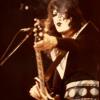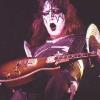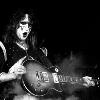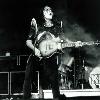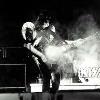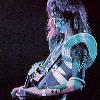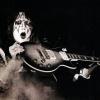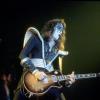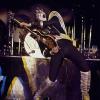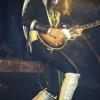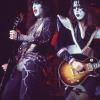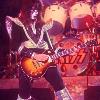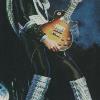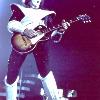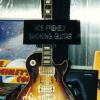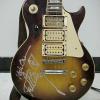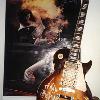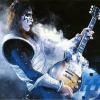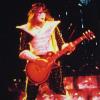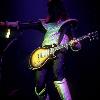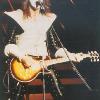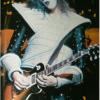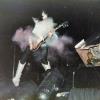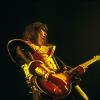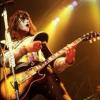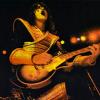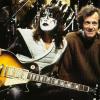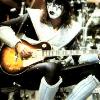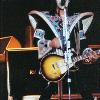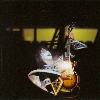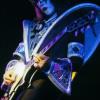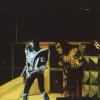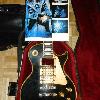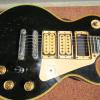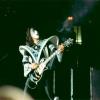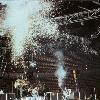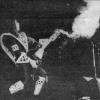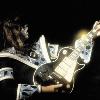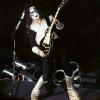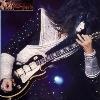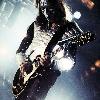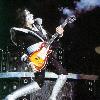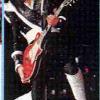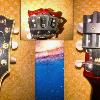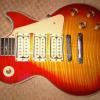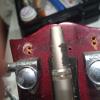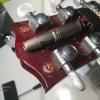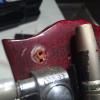Solos, Smokers & Shooters -
"We were on our first tour of Canada and I got some fireworks and said to myself, 'I wonder what would happen if I put a smoke bomb inside my Les Paul' ? I put it in the cavity that holds the potentiometers. It was just a regular store-bought smoke bomb with a fuse that I lit with a cigarette lighter and smoke just started pouring out of the pickups - and it looked great. But I had to keep changing the volume and tone controls because smoke kept getting in there. Eventually I got together with a designer and we figured that it would be better to modify the guitar and isolate the effect in the rhythm pickup, which I don't use anyway " - Ace Frehley (Guitar World , September 1996)
On this page, I'll be talking about Ace's live solos. I originally hadn't planned to go into this topic at all, but as I built the site, I realized that this is such an integral part of Ace and his style, that it really does relate to the Signature Les Paul, albeit indirectly. It really is one part of Kiss' live show that still makes people go "WOW" and ask how it was done. Especially since nobody else in the world does this but Ace !
As I've been digging into the topic of Ace's Smokers in particular, I've come to realize that there might have been multiple guitars, designated as his Smokers, at any one time. Especially as the 'size' and 'spectacle' of the effect grew. I'm fairly certain that up until the Love Gun/Alive II tours, there was only one guitar used as his Smoker. But, it's at that point that the trail becomes that much more difficult to follow. So, I'm not saying that what I've written below is "the gospel of Ace's Smokers", by any stretch. But, it is the best I can provide, with the research I've done and subsequently, the evidence I've found.
Solos
As live guitar solos go, Ace's were/are pretty basic. They were/are typically performed in the key of 'A' (even if the song the band was playing wasn't in 'A') and followed his usual "blues box position" religiously. Hey, if it ain't broke .... don't fix it ! His 'sloppier' style of playing would help to add some spice to what would otherwise be a pretty straight forward interlude. One of Ace's greatest contributions to lead guitar playing, yet one that he gets very little (if any) credit for, is the technique known as tapping. The roots of tapping go back as early as the 1950's and Genesis guitarist, Steve Hackett was using it regularly, by 1971. Ace was the first 'mainstream' guitar player to utilize the technique, going back as early as 1974. Ace's variation on the technique pressed the edge of his pick, instead of his finger-tip, against the string. This would limit him to using only the high 'E' string, but, the sonic impact it made was huge ! Ace really laid the foundation and paved the way for the players in the late 1970s and throughout the 1980's, who took the technique to the next level.
Hopefully, the information below will help to tie all of these elements, "Solos, Smokers & Shooters", together.
Kiss - 1973/74
Video Link: n/a
"Acrobat"
Unknown guitar type
Each member of the band would take a solo in the song
Hotter Than Hell - 1974/75
"Watchin' You"
Tobacco-burst Deluxe (with star-shaped decal)
First shooter
It's a little hard to tell exactly when Ace's recount of "being on tour in Canada and going into a fireworks store ...", actually took place. On 31Jan75, during the "Hotter Than Hell" tour, Ace's guitar didn't smoke. By 25Jan76, during the "Dressed To Kill" tour, it did. So, between those two dates we know the 'Smoker' was born. The problem is that Kiss never played anywhere in Canada, between those dates.
Being that I'm Canadian, I know what time of year fireworks are readily available in this country. I'm going to assume that Ace is referring to a stretch of Canadian dates from 16 to 20May74. We celebrate Queen Victoria's birthday on the 24May and fireworks are a big part of that day. As such, they're available, in just about any corner store and/or gas station, across the country. The only sticking point there, is that those dates were not Kiss' first Canadian tour. Technically, their very first concert tour actually began in Canada, on 05Feb74, in Edmonton, AB. In any event, the "Smoking" guitar would eventually become synonimous with the name Ace Frehley. If you saw Ace play, you saw a smoking guitar !
Looking back at pictures and video footage, the "Hotter Than Hell" tour of 1974 seems to be where Ace's trademark solos find their roots. The first "trick" to work it's way into the show and Ace's solo, was the firework shooting guitar. In Kiss' early days, Ace only had the one Tobacco-burst Les Paul Deluxe...the one that would eventually have the 'star-shaped' decal on the head. So, this was the one that started it all. The original effect was a very simple little firework that shot a few sparks, a puff of smoke and some colored streamers about 10 to 12 feet. It was attached to the back of the head of the guitar and Ace triggered it with the thumb of his left hand. The effect is clearly seen on the Winterland Ballroom, San Francisco, CA concert footage, from January 31, 1975.
Dressed to Kill / Alive - 1975/76
Video Link: January 26, 1976, Cobo Hall, Detroit, MI
Audio Link: May 23, 1976, RAI Arena, Amsterdam, Netherlands (audio only)
"She"
Shooter early on but gone by the end / First smoker / Ace used a match or lighter to ignite the smoke-bomb
Guitar effects - Delay
When the smoker effect began, it was very 'low-tech'. Since he had only one guitar, (the one with the star-shaped decal) that guitar was the original 'Smoker'. Prior to the show, a smoke bomb was placed into the potentiometer cavity, in the back of the guitar with the wick left hanging out just enough to be lit with a lighter or a match. The smoke would work it's way though the body of the guitar and eventually find it's way out, through the pickups, potentiometers and toggle switch cavities. If you watch carefully, on the video from the "Alive" concerts, you can see Ace drop the lighter or match after the effect is lit. At ths point, there was no 'glowing' pickup.
The first "Shooter" effect was being used at the beginning of the Alive! tour but I can't be 100% certain it lasted until the tour concluded. The bootleg audio recordings from the European leg don't seem to support it's use. Video evidence suggests that it wasn't used at all during the tours for "Destroyer", "Rock And Roll Over", "Love Gun" or "Alive II". I'm confident to say that the effect was cut from the show because of the need for Kiss to play larger and larger venues and the fact that a bigger and better but safe-to-use effect just didn't exist, in the mid-'70's.
Destroyer - 1976
Video Link: August 13, 1976, The Summit, Huston, TX
Video Link: August 20, 1976, Anaheim Stadium, Anaheim, CA
Audio Link: September 06, 1976, Varsity Stadium, Toronto, ON (audio only)
**Note - You can definitely hear Ace's solo evolving over the entire year, of 1976.
"Cold Gin"
2nd Tobacco-burst Deluxe (no star-shaped decal)
1 XLR/Mic cable and 1 instrument cable into guitar / Trap-door fake pickup /
Smoke & light controlled with the neck pickup tone knob /
Guitar on a 'steel pyramid' stand at the end of the solo / Explosion from inside the pyramid stand
Guitar effects - Delay, Phaser, Octaver
As the band began to make more money, Ace could afford a second Les Paul. The second (or new) Tobacco-burst Deluxe would take over as the smoker and his original guitar would suffer less abuse. Around the beginning of the "Destroyer" tour, Ace expanded on the Smoking guitar effect by adding what would appear to be a pickup becoming "white hot" as he played his solo. This was achieved with a slightly more 'high-tech' approach. Ace's guitar (the one without the 'star shaped' decal) would have a hole drilled into the side, just between the jack for the guitar cable and the strap button. This was actually an XLR jack where a mic cord was plugged in. The mic cord was taped together with Ace's guitar cord and run out to the stage. A phantom power signal, from the on-stage monitor desk, was run through the mic cord supplying power to the halogen bulb, which created the "white hot" pickup effect and ignited the smoke bombs.
The "white hot" pickup was actually a small halogen light bulb, like you'd find in a regular sound board lamp. They plug straight into an XLR input, on the board and illuminate the board, for the sound tech. The bulb was inserted into the pickup cavity usually occupied by the rhythm pickup. Ace had the real pickup removed (he never used it anyway) and had a plastic insert, which looked like a pickup put in it's place. During his solo, Ace would punch in the plastic insert, with his pick, just as his roady would turn on the phantom power, running through the XLR cord. The smoke would continue to pour out and now that visual was enhanced with the glow of the "white hot" pickup ! Very simple, but very smart and totally in keeping with a band that was so visual, in every respect.
Rock 'N' Roll Over - 1976/77
Video Link: January 29, 1977, Cobo Hall, Detroit, MI
Audio Link: March 28, 1977, Aichiken Taiiku Hall, Nagoya, Japan (audio only)
Video Link: April 04, 1977, Budokan Hall, Tokyo, Japan
"Cold Gin"
2nd Tobacco-burst Deluxe (XLR/Mic cable is now gone)
Smoker / Trap door fake pickup / Smoke & light controlled with the neck pickup tone knob /
Guitar on a 'steel pyramid' stand at the end of the solo / Explosion from inside the pyramid stand
Guitar effects - Delay, Phaser, Octaver
The "white hot" pickup effect didn't change, between the Destroyer and Rock And Roll Over tours, with the exception of the elimination of the XLR cable, supplying power to the guitar, for the effect. By January of 1977, it would seem that a couple of D cell batteries took the XLR cable's place. In the video footage from 29Jan77, in Detroit and from 04Apr77, in Tokyo, you can clearly see the hole beside the output jack, on Ace's guitar, where the XLR cable had been, previously. The use of the D cell batteries wouldn't change until the invention of reliable, rechargable batteries. But it also meant that virtually the entire back side of Ace's smokers, had to be hollowed out, in order to accomodate the effects mechanisms.
Love Gun / Alive II - 1977/78
Video Link: September 01, 1977, The Summit, Houston, TX
Video Link: December 20, 1977, Capital Center, Largo, MD
Audio Link: January 23, 1978, Roberts Municipal Stadium, Evansville, IN (audio only)
Audio Link: March 28, 1978, Budokan Hall, Tokyo, Japan (audio only)
Audio Link: March 31, 1978, Budokan Hall, Tokyo, Japan (audio only)
Audio Link: April 02, 1978, Budokan Hall, Tokyo, Japan (audio only)
"Shock Me"
2nd Tobacco-burst Deluxe (XLR/Mic cable is gone)
Smoker / Trap door fake pickup / Smoke & light controlled with the neck pickup tone knob /
Guitar on a 'steel pyramid' stand at the end of the solo / Explosion from inside the pyramid stand
**Note - Around this point in time, it becomes pretty difficult to keep track of Ace's Smokers. It would see that there were several of them, in steady rotation, for the live shows. They were ALL Tobacco-burst Les Pauls and towards the end of the Love Gun tour and the beginning of the Alive II tour, they were pretty much exclusively, Les Paul Standards.
The "2nd" Tobacco-burst Les Paul Deluxe had lived a good, full life. But, by the end of the Love Gun tour, in September of 1977, the guitar was apparently retired. The effect needed to be LARGER in order to keep up, visually, with the larger venues the band was playing. Subsequently, the heat generated by the effect had actually started to burn through the body of the guitar, just above and below the neck pickup. The hole below the pickup was concealed by the pickguard, but the hole above it is clearly visible in pictures and video, from the period.
New Tobacco-burst Standards
Smoker / Trap door fake pickup / Smoke & light controlled with the neck pickup tone knob /
Guitar on a 'steel pyramid' stand at the end of the solo / Explosion from inside the pyramid stand
Guitar effects - Delay, Octaver
For the Alive II tour, Ace employed a new Tobacco-burst Les Paul Standard, as his smoker. The color of the Tobacco-burst guitars, of the late '70s was/is very different from that of the early '70s. The outter edges are such a dark brown, that they look almost black. If you can't see the word "Standard" on the truss rod cover, this is the easiest was to spot a late-70s, over an early-70s, version.
Dynasty - 1979
Video Link: July 08, 1979, Capital Center, Largo, MD
Audio Link: August 06, 1979, The Forum, Montreal, PQ (audio only)
Audio Link: September 24, 1979, Sports Arena, Milwaukee, WI (audio only)
Audio Link: November 21, 1979, Seattle Center Coliseum, Seattle, WA (audio only)
**Note - The above show in Seattle was recorded 2 days after I saw Kiss, for the first time,
on November 19, 1979, at The Pacific Coliseum, Vancouver, BC
"2,000 Man"
Tobacco-burst Standard used during the Alive II tour
Smoker / Trap door fake pickup / Smoke & light controlled with the neck pickup volume knob /
Small hook on the back of the head flies guitar into the light rigs
**Note - I believe this guitar to be the one Steve Carr talked about trying to fix after it fell from the
lighting rigs and snapped it's head, shortly after the beginning of the Dynasty tour. It was then replaced by ...
New 3 pickup Black Customs
Smoker / Trap door fake pickup / Smoke & light controlled with the neck pickup volume knob /
Small hook on the back of the head flies guitar into the light rigs
**Note - This Shooter was originally intended to be the "Laser" guitar that Steve Carr talked about.
2nd new 3 pickup Black Custom
Shooter / Aimed at the Smoker hanging in the lighting rigs / 3 shots controlled by pushing the rhythm tone knob
Guitar effects - Delay, Octaver
By 1979, technology and money would lend themselves to the re-introduction of the "Shooter" on the "Dynasty" tour. By this point Ace's "Shooter" had moved up the ladder to a 3 pickup Black Custom. The fireworks were again mounted on the back of the head of the guitar in a double cylinder unit. Ace would again trigger them himself; this time with his right thumb pushing down on what is traditionally the volume knob for the neck pickup on a Les Paul. The workings of this new version of the effect were conceived by Ace and refined by Kiss' guitar tech, at the time, Steve Carr. Ace's target was his smoking Les Paul ... which Ace would play during the first part of his solo ... and was now hanging by a wire, high up above the stage, in the lighting rigs. Ace would trigger the firework, which shot across the stage and up. When it hit the hanging guitar, a small, secondary explosion was triggered. The fireworks never actually did any serious damage to the first guitar or the lighting rig. But, the effect was very cool !!!
From this point on, there were never really any other advancements, changes or modifications to Ace's "Solos, Smokers & Shooters", other than the guitars themselves.
Unmasked - 1980
Audio Link: August 29, 1980, Castel Sant'Angelo, Rome, Italy (audio only)
Audio Link: October 05, 1980, Groenoordhallen, Leiden, Netherlands (audio only)
Audio Link: December 03, 1980, Western Springs Stadium, Auckland, New Zealand (audio only)
**Note - 03Dec80 was Ace's last, full length, show with Kiss until the Reunion tour, in 1996
"2,000 Man"
3 pickup Black Custom
Smoker / Recessed fake neck pickup / Smoke & light controlled with the neck pickup volume knob /
Small hook on the back of the head flies guitar into the light rigs
2nd 3 pickup Black Custom
Shooter / Aimed at the Smoker hanging in the lighting rigs / 3 shots controlled by pushing the rhythm tone knob
Guitar effects - Delay, Octaver
Reunion - 1996/97
Video Link: June 15, 1996, Irvine Meadows Amphitheater, Irvine, CA (technically the 1st show of the Reunion tour)
Video Link: June 28, 1996, Tiger Stadium, Detroit, MI
Video Link: August 6, 1996, Skydome, Toronto, ON (I was at this show ... on the floor, 9 rows from the stage)
Video Link: October 21, 1996, Allstate Arena, Chicago, IL
Video Link: January 22, 1997, Osaka Castle Hall, Osaka, Japan (Gene Simmons lost his voice - Paul Stanley sang Gene's parts)
Audio Link: March 14, 1997, River Plate Stadium, Buenos Aires, Argentina (audio only)
Video Link: March 28, 1997, Copps Coliseum, Hamilton, ON (my son's first Kiss concert)
Video Link: July 5, 1997, Finsbury Park, London, England
"Shock Me"
New modified Cherry-burst Custom
Smoker / Recessed fake neck pickup / Smoke & light controlled with the neck pickup volume knob /
Small hook on the back of the head flies guitar into the light rigs
2nd 3 pickup Black Custom
Shooter / Aimed at the Smoker hanging in the lighting rigs / 3 shots controlled by pushing the rhythm tone knob
Guitar effects - Delay, Octaver
Psycho Circus - 1998/2000
Video Link: November 15, 1998, Pepsi Arena, Albany, NY
Video Link: December 2, 1998, Skydome, Toronto, ON (my daughter's 1st Kiss concert)
Video Link: December 29, 1998, Rosemont Horizon, Chicago, IL
Video Link: March 4, 1999, Scandinavium, Gothenburg, Sweden
"Into The Void"
"2000 Man"
New Ace Frehley Signature Les Paul
Smoker / Recessed fake neck pickup / Smoke & light controlled with the neck pickup volume knob /
Small hook on the back of the head flies guitar into the light rigs
2nd Ace Frehley Signature Les Paul
Shooter / Aimed at the Smoker hanging in the lighting rigs / 3 shots controlled by pushing the rhythm tone knob
Guitar effects - Delay, Octaver
Farewell - 2000/2001
"Into The Void"
Video Link: June 23, 2000, Air Canada Centre, Toronto, ON (the last Kiss concert I would attend)
Video Link: October 7, 2000, North Charleston Coliseum, North Charleston, SC (final show with the 4 original members)
"2000 Man"
Video Link: March 13, 2001, Tokyo Dome, Tokyo, Japan
Video Link: March 22, 2001, Osaka Castle Hall, Osaka, Japan
Video Link: April 13, 2001, Carrara Stadium, Gold Coast, Australia (Ace's last show with Kiss)
"Shock Me"
New Ace Frehley Signature Les Paul
Smoker / Recessed fake neck pickup / Smoke & light controlled with the neck pickup volume knob /
Small hook on the back of the head flies guitar into the light rigs
2nd Ace Frehley Signature Les Paul
Shooter / Aimed at the Smoker hanging in the lighting rigs / 3 shots controlled by pushing the rhythm tone knob
Guitar effects - Delay, Octaver
1974/75 Version 1 - Crude but very effective Shooter & Smoker
1976/77 Version 2 - The introduction and removal of the XLR cable, feeding the smoke effect
1977 Version 2 (?) - The holes burned through the body,
signalling the end of version 2 (if it's the same guitar)
1977/78 Version 3 - The beginning of the Alive II tour and a new smoker for Ace
1978/79 Version 3 & Version 4 - The end of the Alive II tour, Kiss Meets The Phantom & The Dynasty tour that would be the demise of Version 3 and the introduction of Version 4
1979/80 Version 4 - Some amazing close-up pictures of Ace's Black LP Custom Smoker
1979/80 - The return of the Shooter or Rocket Launcher guitar
1997-2001 - The Shooter or Rocket Launcher guitars
The Black LP Custom Shooter is a Gibson Custom Shop 1957 Reissue, built in 1996. Ink stamped serial number - 7 6144
1998-2001 - FANTASTIC, close-up shots of Ace's Shooter/Rocket Launcher guitar from the Psycho Circus
and Farewell tours.
This guitar is actually a 1998, Production model (Gibson USA) of Ace's signature guitars.
..
